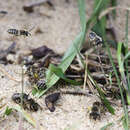zh-TW
在導航的名稱


The bee subfamily Andreninae is a nearly cosmopolitan lineage, with most of its diversity in one genus, Andrena, which contains over 1500 species. The remaining four genera in the subfamily only contain a total of 9 species.
Females of three of the genera (Ancylandrena, Andrena, and Megandrena) have broad, velvety depressions called "facial foveae" on the face between the eyes and the antennae; in all other members of the family, the foveae are much smaller, typically reduced to grooves or pits at the upper margin of the eyes. Ancylandrena and Megandrena occur only in the desert regions of southwestern North America (Nevada, California, Arizona, Sonora, and Baja California), while Andrena is nearly worldwide. Euherbstia and Orphana are rare bees restricted to desert regions of Chile.
Unlike the subfamily Panurginae, none of the species of Andreninae have yellow markings anywhere other than on the face; those markings, when present, are usually found only in males.
The bee subfamily Andreninae is a nearly cosmopolitan lineage, with most of its diversity in one genus, Andrena, which contains over 1500 species. The remaining four genera in the subfamily only contain a total of 9 species.
Females of three of the genera (Ancylandrena, Andrena, and Megandrena) have broad, velvety depressions called "facial foveae" on the face between the eyes and the antennae; in all other members of the family, the foveae are much smaller, typically reduced to grooves or pits at the upper margin of the eyes. Ancylandrena and Megandrena occur only in the desert regions of southwestern North America (Nevada, California, Arizona, Sonora, and Baja California), while Andrena is nearly worldwide. Euherbstia and Orphana are rare bees restricted to desert regions of Chile.
Unlike the subfamily Panurginae, none of the species of Andreninae have yellow markings anywhere other than on the face; those markings, when present, are usually found only in males.
Andreninae es una subfamilia de abejas de la familia Andrenidae. Es casi cosmopolita, predominantemente holártica. El género más numeroso es Andrena con 1500 especies. Los cinco géneros restantes contienen solamente una docena de especies.
Las hembras de los tres géneros (Ancylandrena, Andrena y Megandrena) tienen fóveas faciales, depresiones suavemente velludas en el rostro entre los ojos y antenas. En los otros géneros las fóveas están muy reducidas, a lo sumo un pequeño surco o puntuación cerca del margen superior del ojo. El género Andrena es casi cosmopolita. Ancylandrena y Megandrena se encuentran solamente en las regiones desérticas del suroeste de Norteamérica, en Nevada, California (Sonora y Baja California); mientras Euherbstia y Orphana están restringidas a las zonas desérticas de Chile.
A diferencia de la subfamilia Panurginae, ninguna de las especies de Andreninae tienen marcas amarillentas en el cuerpo, solamente en el rostro; generalmente estas marcas están presentes solo en los machos.
Andreninae es una subfamilia de abejas de la familia Andrenidae. Es casi cosmopolita, predominantemente holártica. El género más numeroso es Andrena con 1500 especies. Los cinco géneros restantes contienen solamente una docena de especies.
Las hembras de los tres géneros (Ancylandrena, Andrena y Megandrena) tienen fóveas faciales, depresiones suavemente velludas en el rostro entre los ojos y antenas. En los otros géneros las fóveas están muy reducidas, a lo sumo un pequeño surco o puntuación cerca del margen superior del ojo. El género Andrena es casi cosmopolita. Ancylandrena y Megandrena se encuentran solamente en las regiones desérticas del suroeste de Norteamérica, en Nevada, California (Sonora y Baja California); mientras Euherbstia y Orphana están restringidas a las zonas desérticas de Chile.
A diferencia de la subfamilia Panurginae, ninguna de las especies de Andreninae tienen marcas amarillentas en el cuerpo, solamente en el rostro; generalmente estas marcas están presentes solo en los machos.
Les Andreninae sont une sous-famille d'insectes hyménoptères de la famille des Andrenidae.
Selon BioLib (27 aout 2021)[1] :
Les Andreninae sont une sous-famille d'insectes hyménoptères de la famille des Andrenidae.